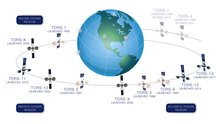cosmos.wikisort.org - Spacecraft
TDRS-7, known before launch as TDRS-G, is an American communications satellite, of first generation, which is operated by NASA as part of the Tracking and Data Relay Satellite System. It was constructed by TRW as a replacement for TDRS-B, which had been lost in the Challenger accident, and was the last first generation TDRS satellite to be launched.
 TDRS-G before launch at Kennedy Space Center | |
| Mission type | Communication |
|---|---|
| Operator | NASA |
| COSPAR ID | 1995-035B |
| SATCAT no. | 23613 |
| Mission duration | Planned: 10 years Elapsed: 26 years, 11 months, 20 days |
| Spacecraft properties | |
| Bus | TDRS |
| Manufacturer | TRW |
| Launch mass | 2108 kg [1] |
| Dimensions | 17.3 metres long 14.2 metres wide |
| Power | 1700 watts |
| Start of mission | |
| Launch date | 13 July 1995, 13:41:55 UTC |
| Rocket | Space Shuttle Discovery STS-70 / IUS |
| Launch site | Kennedy Space Center, LC-39B |
| Contractor | Rockwell International |
| Orbital parameters | |
| Reference system | Geocentric orbit |
| Regime | Geostationary orbit |
| Longitude | 150.0° West (1995–1996) 171.0° West (1996–2003) 150.5° West (2003–) |
| Epoch | 14 July 1995 [2] |
History
TDRS-7 is based on a custom satellite bus which was used for all seven first generation TDRS satellites.[3] Whilst similar to its predecessors, it differed from them slightly in that twelve G/H band (C band (IEEE)) transponders which had been included on the previous satellites were omitted.[4] It was the last communications satellite, other than amateur radio spacecraft, to be deployed by a Space Shuttle.
Launch

The TDRS-G satellite was deployed from Space Shuttle Discovery during the STS-70 mission in 1995. Discovery was launched from Kennedy Space Center Launch Complex 39B at 13:41:55 UTC on 13 July 1995.[5] TDRS-G was deployed from Discovery around six hours after launch, and was raised to geosynchronous orbit by means of an Inertial Upper Stage.[5]
Deployment
The twin-stage solid-propellent Inertial Upper Stage made two burns. The first stage burn occurred around an hour after deployment from Discovery, and placed the satellite into a geosynchronous transfer orbit. At 02:30 UTC on 14 July 1995 it reached apogee, and the second stage fired, placing TDRS-G into geostationary orbit.[6] At this point, it received its operational designation, TDRS-7. It was placed at a longitude 150.0° West of the Greenwich Meridian, where it underwent on-orbit testing. In May 1996, it was moved to 171.0° West where it was stored as an in-orbit spare, and subsequently entered service.[7] In December 2003, it was relocated to 150.5° West.[8] It arrived the next month, and was returned to storage as a reserve satellite.


See also
- List of TDRS satellites
References
- "UCS Satellite Database". Union of Concerned Scientists. 1 July 2009. Retrieved 9 August 2009.
- "NASA - NSSDCA - Spacecraft - Trajectory Details". nssdc.gsfc.nasa.gov. Retrieved 2 May 2018.
 This article incorporates text from this source, which is in the public domain.
This article incorporates text from this source, which is in the public domain. - Krebs, Gunter. "TDRS 1, 2, 3, 4, 5, 6". Gunter's Space Page. Retrieved 9 August 2009.
- Krebs, Gunter. "TDRS 7". Gunter's Space Page. Retrieved 9 August 2009.
- McDowell, Jonathan. "Launch Log". Jonathan's Space Page. Retrieved 9 August 2009.
- McDowell, Jonathan. "Index". Geostationary Orbit Catalog. Jonathan's Space Page. Retrieved 9 August 2009.
- "The TDRS-J satellite". Spaceflight Now. 1 December 2002. Retrieved 9 August 2009.
- "TDRS 7". TSE. Retrieved 9 August 2009.
На других языках
- [en] TDRS-7
[es] TDRS-7
TDRS-7, conocido antes del lanzamiento como TDRS-G, es un satélite de comunicaciones estadounidense operado por la NASA como parte del Tracking and Data Relay Satellite System.[1][2] Fue construido por TRW como reemplazo del TDRS-B, que se había perdido en el accidente del Challenger, y fue el último satélite TDRS de primera generación en ser lanzado.Другой контент может иметь иную лицензию. Перед использованием материалов сайта WikiSort.org внимательно изучите правила лицензирования конкретных элементов наполнения сайта.
WikiSort.org - проект по пересортировке и дополнению контента Википедии
